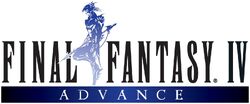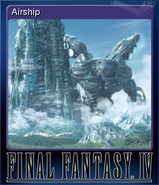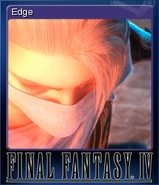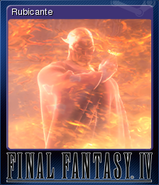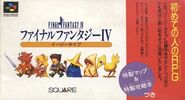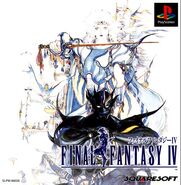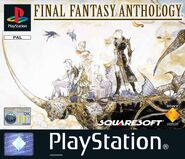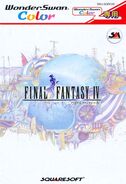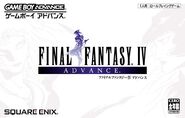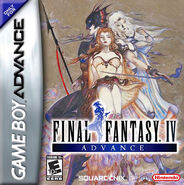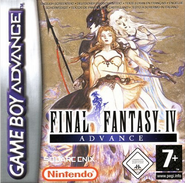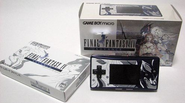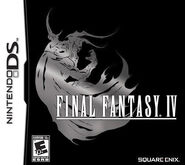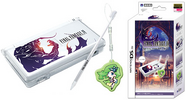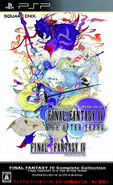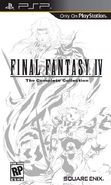Bid farewell to your bloodstained past
Final Fantasy IV box (DS)
Final Fantasy IV is the fourth main installment in the Final Fantasy series, developed and published by Squaresoft. It was released in July 1991 for the Super Nintendo Entertainment System in Japan, and released as Final Fantasy II in North America in November 1991 (with alterations made due to Nintendo of America's guidelines at the time). It has subsequently been re-released worldwide as Final Fantasy IV for the PlayStation, Game Boy Advance, and other platforms, as well as a re-release on PlayStation Portable as part of a collection with its two sequels, and as part of Final Fantasy Pixel Remaster series. A three-dimensional remake, developed by Matrix Software and published by Square Enix, was released for the Nintendo DS, iOS, Android, and Steam platforms. The game was directed by Hironobu Sakaguchi, with Yoshitaka Amano providing the character designs and Nobuo Uematsu composing the score. It was the first title developed for the Super Nintendo Entertainment System and the second overall to release in North America.
The game takes place in a medieval fantasy setting, and focuses on Cecil Harvey, the captain of the Red Wings of Baron. After performing a raid on Mysidia to steal the Water Crystal, Cecil and the knights question the orders of their king as they believed stealing from the Mysidians was wrong. As punishment for disloyalty, the king strips Cecil of his title, and orders him and Kain Highwind to win back his trust by sending him to the village of Mist. This sets Cecil off on an adventure in which he and many other allies he meets must uncover the truth and save the world from monsters.
Final Fantasy IV introduced the iconic Active Time Battle system, in which characters' moves are represented by a gauge that slowly fills up, allowing them to perform an action when the gauge is full. A party consists of up to five characters, each with up to three unique abilities. Characters unlock new abilities and improve their stats as they level up. In the 3D versions, additional customization is available in the form of Augments, that allow characters to use different abilities.
A sequel, Final Fantasy IV: The After Years, was released for Japanese mobile phones in February 2008. The sequel was released via WiiWare in the US on June 1, 2009, and is included in Final Fantasy IV: The Complete Collection for the PlayStation Portable, along with a "midquel" titled Final Fantasy IV -Interlude-.
In 2021, Final Fantasy IV celebrated its 30th anniversary with a modest social media campaign that launched in mid-July. In addition to releasing on at least one console or handheld for each generation following the SNES, the game has enjoyed a substantial following on mobile devices since 2009's release of the 3D remake to iOS and Android. A from-the-ground-up remake of the original 2D version was released September 8, 2021 as part of the Final Fantasy Pixel Remaster collection.
Gameplay[]
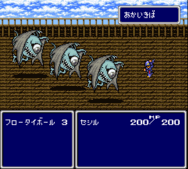
A battle scene from the original Japanese version of the game.
Characters traverse an overworld to fulfill requirements of various quests, using towns to replenish strength, buy new equipment, and discover clues, all the while fighting monsters at random intervals. The game introduces the Active Time Battle (ATB) system to the series where players must issue orders to their characters in real-time. The ATB system would return in the next five games as well as making appearances in other games produced by Square Co., Ltd., including Chrono Trigger.
In battle, the player controls a party with up to five characters, making Final Fantasy IV the first and only Final Fantasy in the main series where the maximum party capacity is greater than four party members. Each character has certain strengths and weaknesses, including either spellcasting powers or other special abilities, based on their job. Characters gain abilities as they gain experience from battles. Magic is divided into four categories: White Magic, Black Magic, Rydia's Summon Magic ("Call" in the SNES version), and a special type of offensive and support magic used by Edge, known as Ninjutsu.
Many enemies can counterattack when attacked under certain conditions. Examples include the Behemoth, the Antlion, and the final boss. Dealing with these enemies requires a variety of strategies, including avoiding using attacks that trigger a counter, using disabling status effects to prevent counters, or using attacks that can kill the enemy in a single hit. This feature was not used as extensively in later Final Fantasy games.
Character shuffling in battle was a problem in Final Fantasy IV; the player could cycle through the entire party twice before getting to select the character they wanted. This was not necessarily caused by the ATB gauge; even with the character's gauge full, one might still need to cycle through the party twice before being able to use them.
Spell casters, which account for eight of the twelve playable characters (Kain, Edward, Yang, and Cid cannot use magic), gain magic spells at pre-programmed experience levels or fixed events in the story; thus the game's ability development system is considered the simplest in the series. This makes it similar to the way spellcasters gain spells in Dungeons & Dragons, as opposed to the purchasing of spells in the original Final Fantasy.
Unlike the original Final Fantasy, almost no time is needed to level grind to advance to the next area, as long as the party does not escape from the majority of random encounters. Another new addition is save points, which became a staple feature.
Synopsis[]
Characters[]
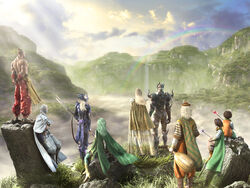
A CG picture of the cast of Final Fantasy IV, excluding Cid, Tellah, and Fusoya (DS).
Final Fantasy IV features twelve playable characters, with Cecil as the main protagonist and the only permanent party member. The characters join and leave the party as dictated by the story.
- Cecil Harvey - Initially a Dark Knight and captain of the Red Wings of Baron, Cecil begins to question his king's motives, which sets off a chain of events that leads him on the path to righteousness.
- Kain Highwind - The commander of the Baron Dragoons, and Cecil and Rosa's childhood friend. He has a rivalry with Cecil and unrequited feelings for Rosa.
- Rydia - A young summoner from the village of Mist. Cecil's need to protect her earns him a formidable ally on his quest.
- Tellah - An elderly Sage driven to exact revenge against Golbez.
- Edward Chris von Muir - The prince of Damcyan and a cowardly Bard who wants to help Cecil in whatever ways he can and is gradually inspired to become more courageous.
- Rosa Farrell - A White Mage and Archer from Baron, her feelings towards Cecil have grown beyond friendship.
- Yang Fang Leiden - The Grandmaster of the Monks of Fabul. He aids Cecil on behalf of his kingdom.
- Palom - A young Black Mage in training from Mysidia. He and his twin sister Porom join Cecil on his journey after being sent to accompany him up Mount Ordeals.
- Porom - A young White Mage in training from Mysidia. She and her twin brother Palom join Cecil on his journey after being sent to accompany him up Mount Ordeals.
- Cid Pollendina - A master engineer who designed various airships for the Red Wings. He is a father figure to Cecil, Kain and Rosa. His airship, the Enterprise, is used by the party to travel around the world.
- Edge Geraldine - The prince of Eblan and a skilled Ninja. He is quick to act on his emotions, but his strong sense of justice prevails.
- Fusoya - A Lunarian from the Red Moon, who sheds some light on the conflict that threatens the Blue Planet.
Story[]
Music[]
The music for Final Fantasy IV was composed by Nobuo Uematsu. Final Fantasy IV was a big development in terms of music, because up until then the games had one piece music per map, but for Final Fantasy IV, they focused on how to make the game more emotional and to have the music play at the right timing.[3]
The boss theme of Final Fantasy IV was slightly remixed and used as the boss theme for the bonus boss Culex from Super Mario RPG: Legend of the Seven Stars, a game that Square worked on. In fact, Culex himself was purposely based on a boss that would be typical in the Final Fantasy series.
Development[]
After Final Fantasy III was finished the team started Final Fantasy IV with the idea of a slightly more action-based, dynamic overworld rather than keeping combat as a separate thing, but the project wound up "not being IV anymore" and was eventually released as Seiken Densetsu 2 (Secret of Mana).[4]
Final Fantasy IV has been released in a variety of different versions for a variety of different platforms. All versions tell the same story, and feature the same characters. There are two distinct versions of the game: the original 2D version whose remasters use the same graphics, sound, music and basic game engine, and the 3D remake version originally released for the Nintendo DS with new graphics, voice acting and additions to the character development system and increased difficulty level. Nonetheless, there are certain key distinctions between each version.
Game design[]
The idea behind creating Final Fantasy IV was to create an "ultimate Final Fantasy game", one that would compile the good aspects of the previous three installments. The story-driven aspect is taken from Final Fantasy II, and the job change elements are taken from the original Final Fantasy and Final Fantasy III. The team wanted to balance the two aspects, ending up with what became Final Fantasy IV.[3]
The series moved from NES to SNES, allowing for the use of more colors and story, although the maximum cartridge capacity still posed a limitation, and developing an expansive, narrative-driven adventure was a challenge with the available space. Takashi Tokita, the game's lead designer, wrote the scenario, but had to cut down a fourth of what he had written to make it fit, although some of the cut material would make it to the 3D remake version. Not everything could be in full color either or they would have run out of memory, and thus certain areas were prioritized: airships, bosses, and main characters with the supplementary aspects' colors being halved.[5]
Up until then, RPGs tended to have a map, a dungeon, a castle, and boss battles, and the player progressed back and forth between gameplay and boss battles. The idea for Final Fantasy IV was to approach it from a movie editing perspective to create a more dramatic, story-driven game. By minimizing player confusion as to where to go next, the developers elevated the story-driven impact.[3]
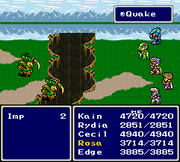
A battle in Final Fantasy IV.
Making Final Fantasy IV a story-driven game led to decreased level of party customization compared to the previous entries to the series. By adding the Active Time Battle system, the goal was to mitigate this.[3] The Active Time Battle system, new for Final Fantasy IV, was created by Hiroyuki Ito who felt that battles in JRPGs would eventually be done in real time. To create a battle system as close to real time as was possible at the time, the Active Time Battle system was born. Ito felt that too many action elements would alienate users and the theme he came up with was an action-like game without reflex action elements.[6]
One thing Ito had in mind was automatic transmissions in cars, as opposed to a stick, but even if processes are automatic, the player had to have something to do, lest they get bored. At the time, there was a shift going on in Formula One racing where semi-automatic transmissions were introduced. From this, the concept where character speed would differ depending on the type of character was coined. With this system, the team could implement an action game type of gimmick where enemies will change shape, or fight as a wall closing in—this was a new kind of enemy structure that had not appeared in a Final Fantasy game before.[3]
Ito felt that implementing that kind of system would give people the illusion that they are doing more to drive the action than what might actually be happening, because of a lot of the processes are automatic.[6] Since Final Fantasy IV, Active Time Battles became the series' staple battle system and evolved to become more complex and player-friendly. Ito felt the system in Final Fantasy IV was not yet complete. In Final Fantasy IV, the charge time for actions depends on the strength of the spell being cast, but this feature was scrapped for subsequent installments because the developers did not want long waiting times, and so the goal in the future was to create a balance between physical and magical abilities.[3]
Easy Type[]
The original Final Fantasy IV was altered in several regards to reduce the difficulty level for Final Fantasy IV Easy Type (ファイナルファンタジーIV イージータイプ, Fainal Fantajī Fō Ījī Taipu?), a version exclusive to Japan. Various spells, abilities and items were removed or altered, shop prices were lowered, and other tweaks to make the game easy were put in place. Many enemies, attacks and items were renamed.
It is often thought the original North American translation was a translation of Easy Type, but the translated version was developed before Easy Type, and the difficulty is reduced further in Easy Type than in the North American version. This led to speculation that Easy Type was based on the North American Final Fantasy II rather than vice versa.
Another aspect Easy Type changed is some of the text, which was simplified to make it easier for younger Japanese players to read and to help bring the point of certain comments across more clearly. For example, when Palom clears the fire on Mt. Ordeals with his Blizzard spell and brags about it, Porom reminds him that the Elder of Mysidia taught them they should not be haughty. The word for "haughty" was replaced with the word for "arrogant", as "haughty" is not a common word in an average child's vocabulary.
Final Fantasy II (North America)[]
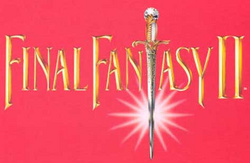
Original logo for Final Fantasy II (SNES).
Final Fantasy IV Easy Type is roughly similar to the game released in North America, but some content was lost to censorship and poor translation when localized. References to religious imagery and names were removed, violence and death were toned down or removed entirely, and various names were changed in all aspects of the game.
Square did not have much of a localization team set up for the project, which made the localization a rocky one, such as the team working till late rewriting the text the best they could without ever having played the game. This led to Square wanting to set up a proper localization team to oversee future localization projects, and to translate the game text and manual.[7]
This version was developed in North America and Takashi Tokita has later recalled the troubles they had developing a game overseas during a time with no Internet. The team copied everything onto disc, but when Tokita arrived at the States he had left it behind in Japan and it had to be sent over on a later day.[3] After the work was finished it took around a two or three-month manufacturing process to have all the ROMs created.[7]
The U.S. version was made easier due to Japan already having three Final Fantasy games, whereas the first Final Fantasy was the only one released in the States.[3] Final Fantasy II and Final Fantasy III had experimental elements, so it was thought to be a challenge for U.S. players to dive straight into Final Fantasy IV. It was decided to balance it out by presenting Final Fantasy IV as a follow-up to the first Final Fantasy, thus it was simplified and named Final Fantasy II. This change was also made with younger players in mind.[3]
Releases[]
Final Fantasy IV was the third Final Fantasy game to be remade.
PlayStation[]
The PlayStation re-release, as a collection of games called Final Fantasy Chronicles alongside Chrono Trigger, is very similar to the original version of Final Fantasy IV. Some minor tweaks introduced in Final Fantasy IV Easy Type have been left in, but these are relatively unnoticeable. The most notable change in the PlayStation release, as it was in the games within Final Fantasy Anthology, is the inclusion of a full motion video opening sequence, the ability to run in dungeons and towns by holding the Cancel button, and the ability to perform a memo save anywhere on the World Map. This save would remain active in the PlayStation's RAM until it was overwritten by another such save, or the power was turned off or interrupted. Unlike the Anthology remakes, though, the PSOne re-release retains the "zoom in" and "pixel" battle scene transitions when a random encounter triggers.
The North American and European localization of Final Fantasy IV PlayStation features an entirely rewritten translation, which addresses most of the discrepancies between the original game and the SNES Final Fantasy II. However, certain sections, such as the line "You spoony bard!", were kept intact, as many of them had achieved cult status.
Currently, this is the only PS1 remake of a console Final Fantasy game that has yet to be released on the U.S. PlayStation 3's PlayStation Store as a PS1 Classic (it is available on the Japanese store).
WonderSwan Color[]
The WonderSwan Color version of Final Fantasy IV lacks the FMVs of the PlayStation version, has decreased screen resolution, and down-sampled music and sound effects to meet the specifications of the device.
However, a number of graphical enhancements were made to character sprites and backgrounds by providing additional details and color shading. The original character portraits were replaced with new, smaller portraits. Also, certain boss sprites were changed to those featured in the Japanese Easy Type version of the Super Famicom game.
The game featured revamped difficulty different from both the original and the Easy Type versions.
Game Boy Advance[]
The Game Boy Advance port was released in North America on December 12, 2005, while the Japanese version was released on December 15, 2005. The Japanese version came with a bonus addition of a themed face plate for the Game Boy Micro which features Yoshitaka Amano artwork of Cecil and Kain. The game is largely based on the WonderSwan Color version. Some changes include the addition of character portraits in text boxes, the ability to switch party members, increased difficulty, and new dungeons with new items and weapons along with new bosses. The script received a re-translation more faithful to the original material. The Quicksave, which allows the player to save the current position (regardless of where) in a file that is deleted upon loading, is featured.
Some minor bugs were introduced, notably in the battle system, possibly as a result of merely porting the game from an existing platform instead of fully optimizing the game for the Game Boy Advance hardware. Examples include party members' turns being skipped and randomly being given two (or, less frequently, more) turns in a row for a single character. There is also some jerkiness while flying airships (more so when going left and right than up and down) and during menu navigation (in and out of battle). The latter makes it less effective to select spells or weapons during fast-paced Active Mode battles. Furthermore, some minor "artistic license" was taken with the soundtrack (the Tower of Babil and Sylph Cave/Summoned Monster Cave themes each have one altered note). Minor lag during boss battles is present. The North American and Australian version of the game has a debug room.
In Japan, a second version of the game was released which corrected most, if not all, of the bugs and problems. The European version of the game derives from the second Japanese version, which makes it the only English release of the improved version.
Nintendo DS[]
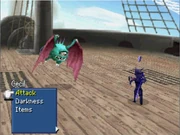
A battle in the DS version.
Final Fantasy IV was released for the Nintendo DS as part of the Final Fantasy 20th Anniversary campaign. The game was developed by Matrix Software, the team responsible for the Final Fantasy III remake, and was supervised by members of the original development team: Takashi Tokita serves as executive producer, Tomoya Asano as producer, Hiroyuki Itō as battle designer. Animator Yoshinori Kanada storyboarded the new cutscenes. The game was released in North America on July 22, 2008.
According to executive producer Takashi Tokita (scenario writer of the original release), 3/4 of the original script had been cut from the Super Famicom release, but some of this lost material was reworked into the remake, while some new events were added. The player has the ability to use the Nintendo DS stylus to move around similarly to the Final Fantasy III remake, while the new minigames require use of the stylus.
The game features an ability system, which adds a degree of replay to the game, as well as a New Game Plus feature and the Quicksave, which allows the player to save the current position (regardless of where) in a file that is deleted upon loading. An "Auto-Battle" system allows the player to leave the parties' battle actions up to commands set in the Abilities menu outside of battle.
In June 2007, Square Enix held a casting for a vocalist to sing a version of "Theme of Love" rearranged by Nobuo Uematsu. It also used a voice cast for the game's cinematic sequences. Some changes and additions to the Nintendo DS release include the introduction of a new ability system called Augments, increased difficulty level with new enemy attack scripts and increased enemy stats, changes to the equipment system, the summon Whyt, which makes use of the DS touch screen, and the aforementioned New Game Plus. With the DS version, the team wanted to appeal to the old users; if the game was too easy there would not be much play value to older fans, so the difficulty level was ramped up to appeal to both new and old players.[3]
Square's original plan for the English version of the DS game was to use the Game Boy Advance version's script, and only touch it up a little. Tom Slattery, the translator, put forward the idea of doing a whole new script from scratch, offering to do it in the span of the original schedule. Square approved and ended up expanding the schedule so Slattery could finish the new script.[8] Slattery was the one who wanted to rename the summons as Eidolons.
The Nintendo DS version had a redesigned logo featuring Golbez. The new logo was not a concept that pre-existed from the original. Yoshitaka Amano, the logo illustrator, has later described the logo as "cool" and said the designer making the logo based on his illustration did a good job merging them. The Golbez illustration was originally ink art, but the logo designer at Square Enix added red in it. Amano himself enjoys dark, boss-like characters, and tends to lean toward these types of illustrations.[9]
The creation of the Nintendo DS version of Final Fantasy IV led to the making of Final Fantasy IV: The After Years as a sequel to Final Fantasy IV and as a companion piece to the DS remake.[3]
Mobile versions[]
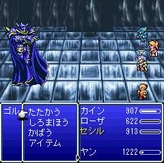
A battle (Mobile).
Final Fantasy IV was ported to Japanese mobile phones on October 5, 2009. The game uses all-new character graphics during and outside of battle, with some taken from Final Fantasy IV: The After Years. This version is based on Final Fantasy IV Advance with many differences. It still incorporates the party-switching feature, and has another post-game bonus "EX Dungeon", which is a remake of the Lunar Ruins.

DS to iOS version comparison.
The DS version was ported for iOS and Android systems with an option to change the game's difficulty level as the DS version is known for being harder than the original. It was released worldwide for many different languages, including Chinese. The graphics were also enhanced. The release was December 20, 2012 for iOS and June 3, 2013 for Android.
The user interface was redone completely as the original was made with the intention of using a controller pad with directional arrows and various buttons, so a lot of trial and error was put into work to optimize the controls on mobile devices.[10]
In April 2014, the iOS app was updated to support Logitech's PowerShell Controller + Battery, a controller for iPhone and iPod touch devices (for iOS 7 only).
In October 2015, the Amazon Appstore version was updated to support the FireTV, game controller support and also cloud saving.
Services for feature phones in Japan were discontinued March 31, 2018 (JST) along with other titles in the Square Enix Mobile portfolio.
Although a new version in the Pixel Remaster series (based on the 2D release) was released September 8, 2021, Square Enix indicated that the 3D version will remain available for the foreseeable future; the title was repackaged before the announcement of the new series and subsequent realignment of the catalog on June 30.
On January 9, 2025, the 3D remakes of Final Fantasy IV and The After Years, alongside the pixel-remastered Final Fantasy, were rebranded and reformatted for the Apple Arcade subscription service, and can be downloaded freely with an Apple Arcade or Apple One subscription package.
PlayStation Portable[]
Final Fantasy IV Complete Collection was released on PlayStation Portable in April 2011, and includes remasters of both Final Fantasy IV and Final Fantasy IV: The After Years. It also includes a new scenario, Final Fantasy IV Interlude, which connects the original game's story with The After Years.
Microsoft Windows and Steam[]
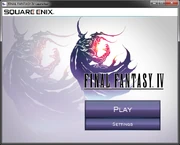
The launcher menu.
The iOS/Android version of Final Fantasy IV was ported and released to Steam on September 17, 2014. It has 58 achievements available. It is compatible with Windows 7, 8, and Vista.
The western release comes with English audio and subtitles in English, French, Italian, German, Spanish, Portuguese, and Russian.
System requirements[]
| Minimum | |
|---|---|
| OS | Windows Vista, 7, 8 |
| Processor | Pentium 4, 2.4 GHz |
| Memory | 2 GB RAM |
| Hard Drive | 750 MB available space |
| DirectX | Version 10 |
Steam Trading Cards[]
The Steam version of Final Fantasy IV comes with 7 Steam trading cards.
Adaptations[]

The first volume of the novelization.
Final Fantasy IV is one of the Final Fantasy games that has been novelized in Japan, and it was split into two volumes. It was written by Ichiro Tezuka, who is also known for writing the scenario to Alundra. He also wrote the novelization for Final Fantasy IV: The After Years.
A comic book adaptation of Final Fantasy IV from Kurt Busiek, Del Barras and Mike Mignola was planned for release in late 1992, when Squaresoft offered Busiek the chance to write an original story set in the world of the first Final Fantasy game and, pleased with his initial outline, decided to let him adapt the story of Final Fantasy IV to tie-in with the game's western release. Four issues were planned and Busiek wrote the script for them with art by comics artist Del Barras and covers by Mike Mignola. The series never happened because Disney's Hollywood Comic, who were going to publish the series, went bankrupt in 1993.[11]
Production credits[]
Original Super Famicom version[]
| Director | Hironobu Sakaguchi |
|---|---|
| Character Design | Yoshitaka Amano |
| Music | Nobuo Uematsu |
| Main Design | Takashi Tokita |
| Main Programmer | Ken Narita |
| Main Graphic Designers | Hiromi Nakada, Ryoko Tanaka |
| Map Design | Yasushi Matsumura |
| Battle Design | Kazuhiko Aoki, Hiroyuki Itou, Akihiko Matsui |
| Battle Programming | Kiyoshi Yoshii, Katsuhisa Higuchi |
| Battle Graphics | Tetsuya Takahashi, Masanori Hoshino |
| Menu Programming | Keitarou Adachi |
| Music Programming | Minoru Akao |
| Sound Effects | Kenji Ito, Akira Ueda |
DS version[]
| Director | Takashi Tokita |
|---|---|
| Battle Supervisor | Hiroyuki Itou |
| Character & Event Art Director | Akira Oguro |
| Background Art Director | Airi Yoshioka |
| Producer | Tomoya Asano |
| Developed by | MATRIX |
Nintendo DS voice cast[]
| Character | Japanese | English |
|---|---|---|
| Cecil Harvey | Shizuma Hodoshima | Yuri Lowenthal |
| Kain Highwind | Kōichi Yamadera | Liam O'Brien |
| Rydia | Noriko Shitaya | Caroline Macey |
| Tellah | Gorō Naya | Doug Lee |
| Edward Chris von Muir | Ryō Horikawa | Sam Riegel |
| Rosa Farrell | Yūko Kaida | Karen Strassman |
| Yang Fang Leiden | Tesshō Genda | Daniel Woren |
| Palom | Rie Kugimiya | Megan Harvey |
| Porom | Rie Kugimiya | Hunter MacKenzie Austin |
| Cid Pollendina | Ichirō Nagai | John Snyder |
| Edge | Hiroya Ishimaru | Taliesin Jaffe |
| Fusoya | Banjō Ginga | Michael McConnohie |
| Golbez | Takeshi Kaga | Peter Beckman |
| Scarmiglione | Konishi Oonishi | Dameon Clarke |
| Cagnazzo | Takeshi Aono | Michael McConnohie |
| Barbariccia | Yūko Kaida | Karen Strassman |
| Rubicante | Norio Wakamoto | Doug Lee |
| Elder of Mysidia | Ryuji Saikachi | William Frederick Knight |
| Anna | Hitomi Akino | Zarah Little |
| Cid's Assistants | Konishi Oonishi | |
| Giott | Takeshi Aono | |
| Luca | Naomi Orikasa | |
| Ship Captain | Takashi Tokita | Michael McConnohie |
| Soldiers | Shingo Okamura Takashi Tokita |
Tom Slattery |
| Kluya | Banjō Ginga | Ralph Lister |
| Zeromus | Ryō Horikawa | Michael McConnohie |
Packaging artwork[]
Allusions[]
Final Fantasy IV makes some allusions to the previous installments in the series, as well as allusions to mythology and literature. E.g. the names of the Four Elemental Archfiends, as well as Calcabrina, have their origin in Dante's Inferno. Each of the archfiends' names corresponds with one of the Malebranche, demons assigned to guard those condemned to the fifth region (Barratry) of the Eighth Circle of Hell (Fraud).
See also[]
- Final Fantasy IV Allusions
- Final Fantasy IV Concept Art
- Final Fantasy IV Translations
- Final Fantasy IV Version Differences
- Final Fantasy IV Wallpapers
- Final Fantasy IV Walkthroughs
External links[]
- Final Fantasy IV Advance Official Japanese Site
- Final Fantasy IV DS Official Japanese Site
- Final Fantasy IV DS Official North American Site
- iTunes Store Purchase Page
- Googleplay Purchase Page
- Steam Purchase Page
- Wikipedia Article
Citations[]
- ↑ Final Fantasy IV (Accessed: April 12, 2018) at Steam
- ↑ (n.d.) . ファイナルファンタジーIV | SQUARE ENIX. Square-Enix.com. Archived from the original on 11 January 2021.
- ↑ 3.00 3.01 3.02 3.03 3.04 3.05 3.06 3.07 3.08 3.09 3.10 A Conversation With the Creator of Final Fantasy IV (dead) (Accessed: May 25, 2016) at 1UP.com
- ↑ Final Fantasy IV, Secret of Mana, and Chrono Trigger Had a Connection (Accessed: August 22, 2018) at Legends of Localization
- ↑ Square Enix Reflects On Final Fantasy's Drive For Cutting-Edge Tech (Accessed: April 24, 2018) at Game Informer
- ↑ 6.0 6.1 Final Fantasy's Hiroyuki Ito and the Science of Battle (dead) (Accessed: October 10, 2015) at 1UP.com
- ↑ 7.0 7.1 Transcript of Ted Woolsey interview (Accessed: August 22, 2018) at Player One Podcast
- ↑ Why Eidolons Were Brought Back For Final Fantasy IV DS And FFXIII (Accessed: August 22, 2018) at Siliconera
- ↑ The Art That Shaped Final Fantasy: Thoughts From Famed Artist Yoshitaka Amano (Accessed: April 24, 2018) at Game Informer)
- ↑ If Square Enix Does Another Final Fantasy IV Remake... (Accessed: August 22, 2018) at Siliconera
- ↑ The Final Fantasy Comic That Never Was (Accessed: August 22, 2018) at Gizmodo




